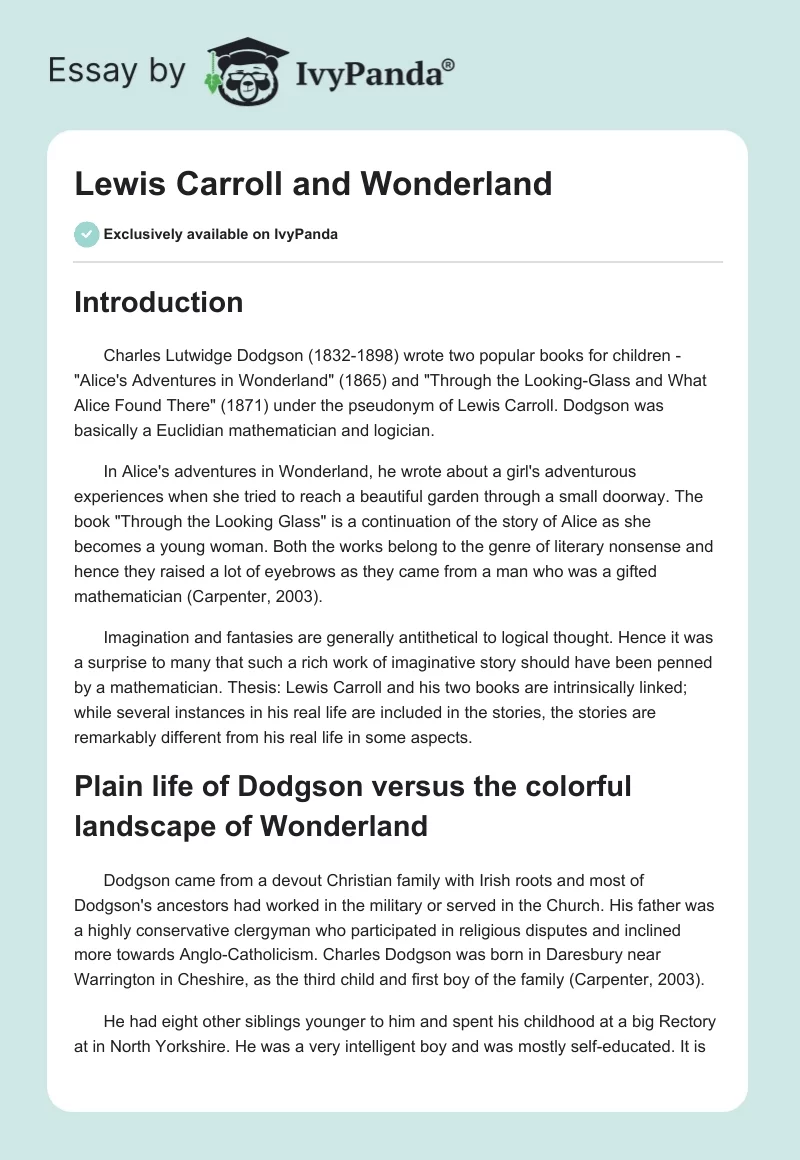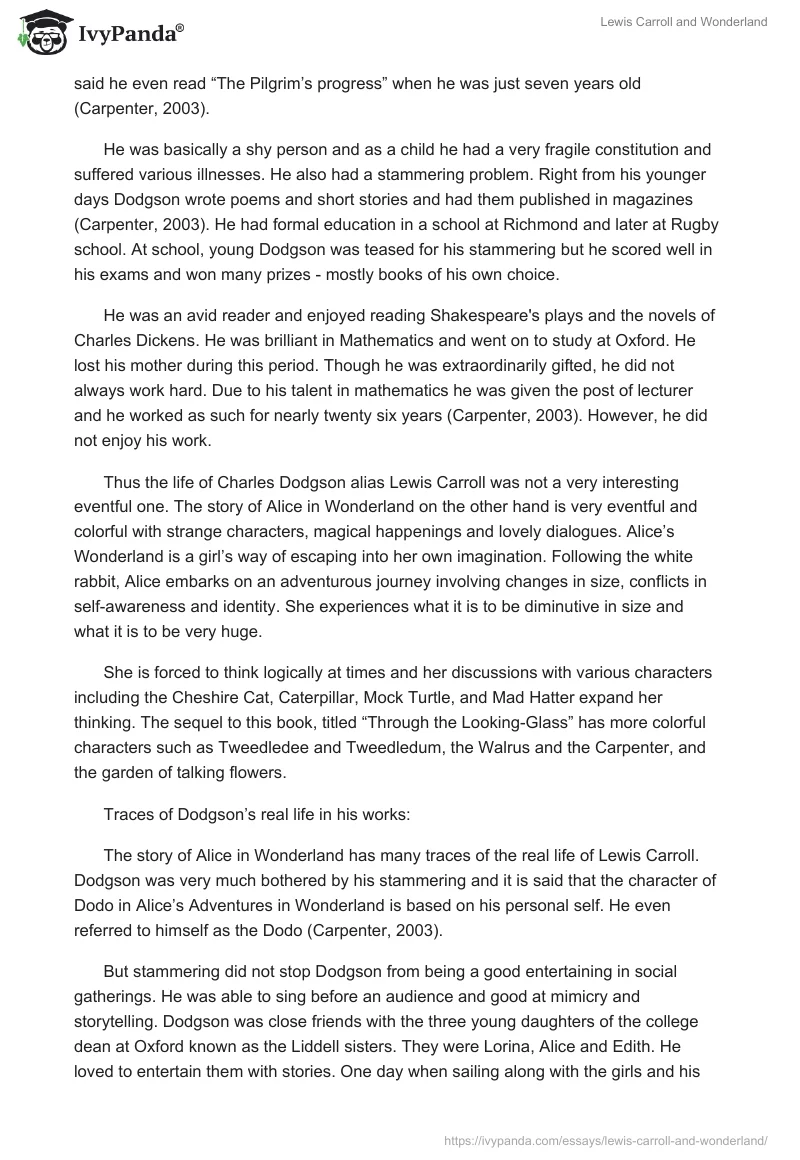Introduction
Charles Lutwidge Dodgson (1832-1898) wrote two popular books for children – “Alice’s Adventures in Wonderland” (1865) and “Through the Looking-Glass and What Alice Found There” (1871) under the pseudonym of Lewis Carroll. Dodgson was basically a Euclidian mathematician and logician.
In Alice’s adventures in Wonderland, he wrote about a girl’s adventurous experiences when she tried to reach a beautiful garden through a small doorway. The book “Through the Looking Glass” is a continuation of the story of Alice as she becomes a young woman. Both the works belong to the genre of literary nonsense and hence they raised a lot of eyebrows as they came from a man who was a gifted mathematician (Carpenter, 2003).
Imagination and fantasies are generally antithetical to logical thought. Hence it was a surprise to many that such a rich work of imaginative story should have been penned by a mathematician. Thesis: Lewis Carroll and his two books are intrinsically linked; while several instances in his real life are included in the stories, the stories are remarkably different from his real life in some aspects.
Plain life of Dodgson versus the colorful landscape of Wonderland
Dodgson came from a devout Christian family with Irish roots and most of Dodgson’s ancestors had worked in the military or served in the Church. His father was a highly conservative clergyman who participated in religious disputes and inclined more towards Anglo-Catholicism. Charles Dodgson was born in Daresbury near Warrington in Cheshire, as the third child and first boy of the family (Carpenter, 2003).
He had eight other siblings younger to him and spent his childhood at a big Rectory at in North Yorkshire. He was a very intelligent boy and was mostly self-educated. It is said he even read “The Pilgrim’s progress” when he was just seven years old (Carpenter, 2003).
He was basically a shy person and as a child he had a very fragile constitution and suffered various illnesses. He also had a stammering problem. Right from his younger days Dodgson wrote poems and short stories and had them published in magazines (Carpenter, 2003). He had formal education in a school at Richmond and later at Rugby school. At school, young Dodgson was teased for his stammering but he scored well in his exams and won many prizes – mostly books of his own choice.
He was an avid reader and enjoyed reading Shakespeare’s plays and the novels of Charles Dickens. He was brilliant in Mathematics and went on to study at Oxford. He lost his mother during this period. Though he was extraordinarily gifted, he did not always work hard. Due to his talent in mathematics he was given the post of lecturer and he worked as such for nearly twenty six years (Carpenter, 2003). However, he did not enjoy his work.
Thus the life of Charles Dodgson alias Lewis Carroll was not a very interesting eventful one. The story of Alice in Wonderland on the other hand is very eventful and colorful with strange characters, magical happenings and lovely dialogues. Alice’s Wonderland is a girl’s way of escaping into her own imagination. Following the white rabbit, Alice embarks on an adventurous journey involving changes in size, conflicts in self-awareness and identity. She experiences what it is to be diminutive in size and what it is to be very huge.
She is forced to think logically at times and her discussions with various characters including the Cheshire Cat, Caterpillar, Mock Turtle, and Mad Hatter expand her thinking. The sequel to this book, titled “Through the Looking-Glass” has more colorful characters such as Tweedledee and Tweedledum, the Walrus and the Carpenter, and the garden of talking flowers.
Traces of Dodgson’s real life in his works:
The story of Alice in Wonderland has many traces of the real life of Lewis Carroll. Dodgson was very much bothered by his stammering and it is said that the character of Dodo in Alice’s Adventures in Wonderland is based on his personal self. He even referred to himself as the Dodo (Carpenter, 2003).
But stammering did not stop Dodgson from being a good entertaining in social gatherings. He was able to sing before an audience and good at mimicry and storytelling. Dodgson was close friends with the three young daughters of the college dean at Oxford known as the Liddell sisters. They were Lorina, Alice and Edith. He loved to entertain them with stories. One day when sailing along with the girls and his friend Robinson Duckworth, Dodgson spun a story for the girls around a little girl named Alice who fell down into a rabbit hole.
When she reached underground, she found herself in the company of some strange creatures: a Mouse, a Duck (named after Duckworth, his close friend and colleague at Oxford, a Lory (for Lorina), an Eaglet (for Edith) and a Dodo (for Dodgson. He told them that Alice and the creatures were wet as they swam to the shore. The girls instantly knew that this was a reference to their last trip on the river when they had gotten wet due to the rain. Dodgson continued the story with his imagination and fantasies.
The book Alice’s Adventures in Wonderland and its sequel “Through the Looking-Glass” were essentially stories created by Dodgson for the Liddell sisters and published under the pen name of Lewis Carrol, on the suggestion of the father of the girls, Henry George Liddell. It is said that Dodgson used a pen name to safeguard his privacy and also to protect his reputation as a logical thinker and mathematician.
The book carried illustrations by John Tenniel. There were many other characters in the book that bore resemblance to real life characters either through their character etching or through their depiction through Tenniel’s drawings. Bill the Lizard is considered by many to refer to the name of Benjamin Disraeli. Tenniel’s drawings of the Lion and the Unicorn appeared to refer to Gladstone and Disraeli respectively.
The Hatter seemed very much like Theophilus Carter, an innovative furniture designer and dealer that Dodgson was familiar with. Experts opine that Tenniel was instructed by Dodgson to draw Hatter in the resemblance of Carter. The story told by the Dormouse has three characters named Elsie, Lacie, and Tillie – obvious references to the Liddell sisters Lorina, Alice and Edith respectively.
The Mock Turtle refers to John Ruskin as a “Drawling-master” who came every week to teach “Drawling, Stretching, and Fainting in Coils” (Carroll, 1865, p. 144). Actually, the Liddell girls studied oil painting and drawing under John Ruskin. When Lewis Carroll visited the Liddell sisters, they sang a song for him called “Star of the evening, beautiful star”. In the book, the Mock Turtle sings “Beautiful Soup” in reference to their song.
Mathematics in Dodgson’s works and in his life
The huge success of Alice in Wonderland and “Through the Looking-Glass” made Lewis Carroll so very popular that whatever he wrote became after than became popular including his articles on Mathematics (Johnson, 1999). Carroll had the talent of making mathematics fun for everyone through his “mind benders, brain teasers and math puzzles” (Johnson, 1999, p. 20). According to mathematician Keith Devlin “Alice in Wonderland” is “a satire on modern mathematics of the mid-19th century” (Devlin, 2010, p. 1).
At the time Dodgson wrote his story, mathematics was undergoing a transformation and becoming more and more abstract. Dodgson did not like those changes and was very conservative (Devlin, 2010). The mushroom that the Caterpillar points to Alice is symbolic of the absurdity of symbolic algebra (Devlin, 2010).
The grin of the Cheshire cat that is left behind after the disappearance of the cat refers to the increasing abstraction in mathematics (Devlin, 2010). In the first chapter, where Alice keeps shrinking, she wonders whether she will simply vanish or end up with a minimal size questioning the concept of limits. In her discussion with the Caterpillar, Alice realizes that proportion was what was more important than length in her world of Euclidean geometry (Bayley, 2010).
In the second chapter, Alice arrives at odd results with multiplication: “Let me see: four times five is twelve, and four times six is thirteen, and four times seven is—oh dear! I shall never get to twenty at that rate!” (Carroll, 1865, p. 20). Here, Alice talks about the representation of numbers using different bases and positional numeral systems (Gardner, 1990). In the fifth chapter, the Pigeon compares little girls to serpents for they both eat eggs, using the concept of abstraction as was the norm during that period.
In the seventh chapter, at the tea-party, there is a strong discussion regarding inverse relationships between the Hare, the Hatter and the Dormouse. At yet another instance, Alice refers the addition of the ring of integers modulo N when she reflects on the how changing sears in circular fashion will bring them back to initial state.
New higher moral identity in Alice and Lewis Carroll
Alice can also be seen as the reflection of the evolution of a new moral identity in its author. According to Ann Reed (2000), Alice evolves through five levels of awareness – or stages of moral reasoning. She first drinks the contents of a bottle to shrink and later eats a cake to become big. However, none of it helps her to reach her goal of passing through the door. Ann Reed says that Alice embodies the conflict between feelings of inferiority and the feelings of superiority that often accompany inner growth.
Reed also points out that these feelings indicate the emergence of a new higher identity. In her talk with the Caterpillar, she confesses that she does not recognize herself due to the various changes in her. Her final outburst and victory over the Queen of Hearts symbolizes the emergence of the new, higher moral identity within her. Carroll, through the character of Alice, traces his own personal inner growth.
Conclusion
Starting out as the son of a clergyman, Carroll became a reader, an explorer, a student, a lecturer, a mathematician, a story teller and finally a writer. The books “Alice in Wonderland” and “Through the Looking-Glass” are intertwined with the real life of the author Lewis Carroll right from the way in which they were conceptualized as stories meant for girls whom he cared for a lot to the success they brought to him as a writer and as a mathematician and a person with a new higher identity.
Bibliography
Carpenter, A. S. (2003). Lewis Carroll: through the looking glass. Twenty-First Century Books
Johnson, A. (1999). Famous problems and their mathematicians. Libraries Unlimited
Reed, M.A. (2000). Composing Dialogues to Express Self-Differentiation and Burke’s Rhetoric: A Way to Comprehend Multilevel Inner Growth. Roeper Review, 23(10):2000, p. 10
Devlin, Keith (2010). The Hidden Math behind Alice in Wonderland. Web.
Carroll, L. (1865). Alice’s Adventures in Wonderland. Macmillan Publishers.
Carroll, L. (1871). Through the Looking Glass and What Alice Found There. Macmillan Publishers.
Gardner, M. (1990). More Annotated Alice. New York: Random House. p. 363
Bayley, M. (2010). Algebra in Wonderland. New York Times, 6 March 2010. Accessed from https://www.nytimes.com/2010/03/07/opinion/07bayley.html


